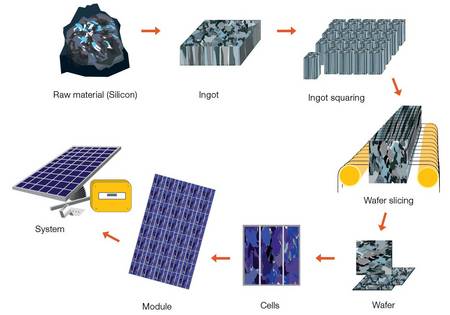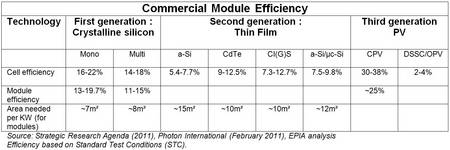Pv Technologies:Cells And Moduls
Pv Technologies:Cells And Moduls
PV Technologies: Cells and Modules
PV cells are generally made either from crystalline silicon, sliced from ingots or castings, from grown ribbons or thin film, deposited in thin layers on a low-cost backing.
The performance of a solar cell is measured in terms of its efficiency at turning sunlight into electricity. A typical commercial solar cell has an efficiency of 15% about one-sixth of the sunlight striking the cell generates electricity. Improving solar cell efficiencies while holding down the cost per cell is an important goal of the PV industry.

Crystalline silicon technology:
Crystalline silicon cells are made from thin slices cut from a single crystal of silicon (monocrystalline) or from a block of silicon crystals (polycrystalline), their efficiency ranges between 11% and 19%. This is the most common technology representing about 90% of the market today.
Three main types of crystalline cells can be distinguished:
Monocrystalline (Mono c-Si)
Polycrystalline (or Multicrystalline) (multi c-Si)
Ribbon sheets (ribbon-sheet c-Si)
Thin Film technology:
Thin film modules are constructed by depositing extremely thin layers of photosensitive materials onto a low-cost backing such as glass, stainless steel or plastic.
Thin Film manufacturing processes result in lower production costs compared to the more material-intensive crystalline technology, a price advantage which is counterbalanced by lower efficiency rates (from 4% to 11%). However, this is an average value and all Thin Film technologies do not have the same efficiency.
Four types of thin film modules (depending on the active material used) are commercially available at the moment:
Amorphous silicon (a-Si)
Cadmium telluride (CdTe)
Copper Indium/gallium Diselenide/disulphide (CIS, CIGS)
Multi junction cells (a-Si/m-Si)

Other cell types:
There are several other types of photovoltaic technologies developed today starting to be commercialised or still at the research level, the main ones are:
Concentrated photovoltaic:
Some solar cells are designed to operate with concentrated sunlight. These cells are built into concentrating collectors that use a lens to focus the sunlight onto the cells. The main idea is to use very little of the expensive semiconducting PV material while collecting as much sunlight as possible. Efficiencies are in the range of 20 to 30%.
Flexible cells:
Based on a similar production process to thin film cells, when the active material is deposited in a thin plastic, the cell can be flexible. This opens the range of applications, especially for Building integration (roofs-tiles) and end-consumer applications.



